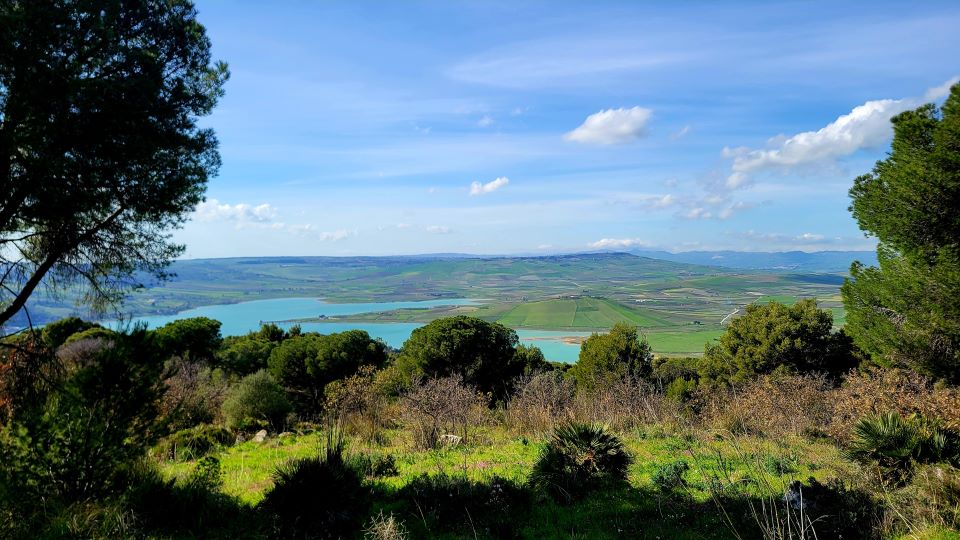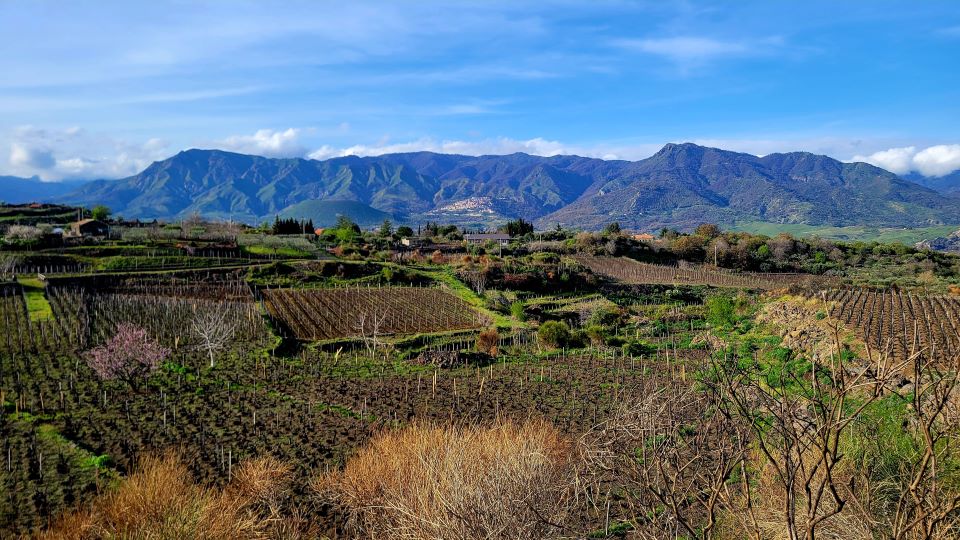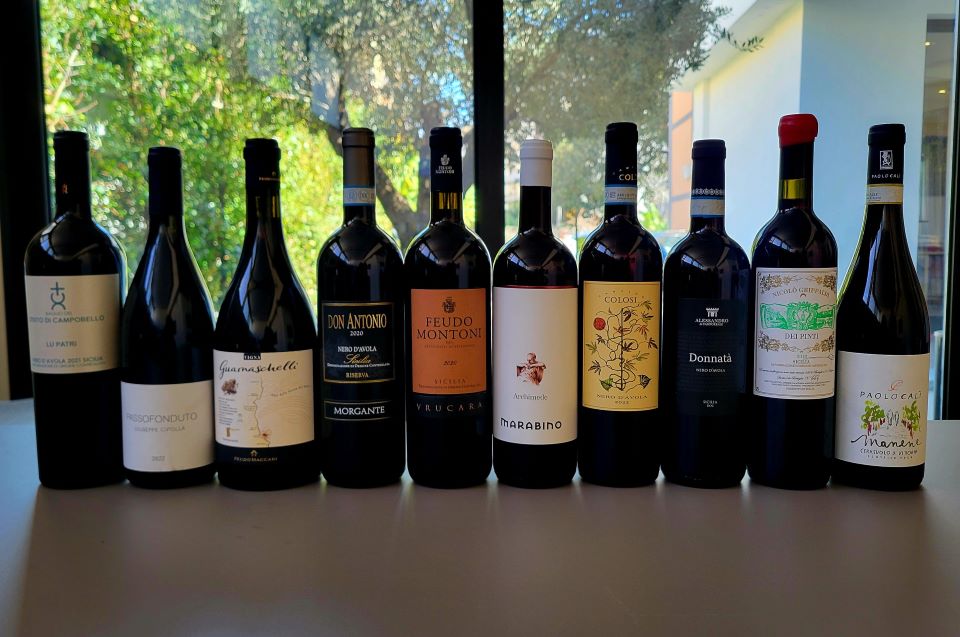Browse using the new Vinous website now. Launch →
Printed by, and for the sole use of . All rights reserved © 2015 Vinous Media
Unveiling the Diverse Palette of Sicily: New Releases and Beyond
BY ERIC GUIDO | JUNE 20, 2024
At the risk of sounding like a broken record, I can’t help but be amazed by the ongoing increase in the quality of the wines of Sicily. Modern-day logic states that it's easy to make technically correct wine and that producers should frankly not release something faulty or disinteresting. Of course, there is a world of difference between a wine that meets the parameters and quality markers that equate to “good” versus one that takes things to another level, communicating a sense of place, tradition and the passion of the people who make it. The latter is Sicily’s specialty. I believe part of this quality surge derives from a sense of pride deeply ingrained in everyone I meet within the industry, from field hand to agronomist to winemaker. Yet it goes even deeper than that, as even an everyday passerby on the streets of Palermo will offer up their opinionated views on the region, its history and just how important their place is in the canon of Italian wine.

Sicily's surprisingly mountainous landscape.
Out of all the tastings I conduct each year, I’d be hard-pressed to find any with such variety and pleasure as Sicily. Sicilian wine is inherently Sicilian in every way imaginable despite the island's size and dramatic climatic differences. These wines are energetic and spicy, often flamboyant and unapologetically sun-kissed in nature, yet possess a vibrant, acidic core that keeps us returning to the glass for more. They range from the most lovable Tuesday night pizza wines to the most distinguished and serious long-term agers.
The diverse terroir of Sicily offers further depths to explore. It’s mountainous, far more so than most consumers realize. The island remains seemingly untouched by the modern world, with thick outcroppings of forests and a natural biodiversity that has thrived throughout millennia. Only in the west, around the cities of Marsala and Menfi, do those mountains taper off to lower elevations that run along the coast. Vines thrive in sandy soils there, with warming air currents blowing up from the African continent. One could leave the city of Palermo on a 55-degree Fahrenheit day and find conditions 15 degrees warmer after just an hour's drive south to Menfi. The volcanic satellite islands of Pantelleria, Salina, Lipari and Vulcano all add flavor to the Sicilian wine scene, presenting unique examples heavily influenced by the surrounding seas. Then there is Mount Etna, which has high elevations, where the Nebrodi and Peloritani Mountains cool the north slopes. In contrast, the south slopes enjoy southern exposures and Mediterranean effects from the Adriatic Sea.
Due to the diversity of Sicily, nearly any grape can find an ideal terroir to thrive. The all-encompassing category of Sicilia DOC allows the island's wineries to feature indigenous and international varieties in a wide range of styles, which is perfect for the curious wine lover. Fruity yet energetic Catarratto, Grillo, Perricone and Zibibbo are abundant, yet each can obtain a level of seriousness in the hands of the right winemaker. The same can be said for Frappato, which I’ve come to consider Sicily’s Beaujolais. I am constantly surprised as efforts from the extreme south make their way to the tasting table. When blended with Nero d’Avola (now we’re talking about inherently serious wine), the two varieties work in concert to create Cerasuolo di Vittoria, a DOCG that’s captured my interest yet sadly doesn’t receive anywhere near the level of attention it deserves from consumers. On the topic of under the radar, Nero d’Avola’s ability to mature beautifully over time and communicate a distinct sense of place has never been as evident as it is today. Each year, I see new projects demonstrating how special Nero d’Avola can be when vinified using more transparent techniques. Additionally, the Etna varieties, Nerello Mascalese, Nerello Cappuccio and Carricante, are paving the way for the region's future. For lovers of international varieties, Sicily has readers covered with a wide range of Cabernet Sauvignon, Cabernet Franc, Syrah, Chardonnay and many more that prove their worth vintage after vintage.
Sadly, Sicily's biggest challenge is one of its best attributes: there are so many varieties and styles to choose from that it can take a lot of work for consumers to know where to start. But with that said, it’s also hard to go wrong. Several long-standing producers, like Tasca d'Almerita, Planeta and Donnafugata, have set up multiple wineries, with their team and specialty, to create portfolios that touch upon all Sicily has to offer. Getting lost in the lineup of any of these names would give wine lovers weeks, if not months, of pleasurable drinking experiences. What’s more, each of them maintains a fantastic level of quality despite their size. Speaking of quality, I’ve seen the most forward momentum in a short time from small, family-run operations. The days of overly rustic, nearly sweet and often forgettable wines are behind us. It’s a perfect time to explore Sicilian wine.

These fiberglass tanks are refining new vintages at the Frank Cornelissen winery.
Mount Etna Continues Its Progress
The writing is on the wall. While Sicily has proven it rightfully deserves its place amongst Italy’s top wine-producing regions, Mount Etna has established itself as one of the most essential viticultural areas in the world. Mark my words, the day Mount Etna receives its own individual coverage, much like the regions of Barolo, Montalcino and Burgundy, will soon be upon us. The progress that I’ve witnessed in the past decade is nothing short of amazing. First, Etna Rosso, a blend of Nerello Mascalese and smaller amounts of Nerello Cappuccio often compared to the likes of red Burgundy and Barolo, captured the imagination of collectors and consumers. Today, there’s even more excitement in the region over the potential future of Etna Bianco (typically varietal Carricante, sometimes blended with Catarratto)and Etna Bianco Superiore, centered around the commune of Milo.
This growth is due to the continued exploration of terroir and how best to take advantage of it. While Mount Etna boasts a winemaking history that goes back thousands of years, it was only 2 decades ago that a handful of courageous and insightful winemakers planted their stakes on this active volcano. At the time, vineyards were up for grabs, but they were also in a severe state of disrepair. The region's winemaking industry had fallen apart in the late 1980s and early 1990s. In fact, there were significantly more plantings around Etna 40 years ago than there are today. At that time, the focus was on producing wine to ship north and overseas and making easy-drinking reds for locals.
In the late 1990s and early 2000s, visionary winemakers such as Frank Cornelissen, Marco de Grazia, Andrea Franchetti and Alberto Graci began to explore the area. They found high-elevation vineyards planted over 100 years ago scattered throughout a nearly alien landscape. Even within the established Contrada of the region, the changes in soils from one plot to another were drastic. This perfect storm of endlessly diverse terroir and vine material was impossible to resist. Within only a matter of years, a new category of Sicilian wine emerged: the Contradas of Mount Etna.

Looking north from Mount Etna toward the Nebrodi and Peloritani mountains.
At the time, Nerello Mascalese’s capacity to combine finesse and grace with depths of fruit drew comparisons to Burgundy, while its power and ability to age reminded some of Barolo. The variety also possessed a fantastic ability to communicate site. Over the next decade, these winemakers and the many who followed in their footsteps obsessed over the soil, documenting lava flows going back hundreds of years. They also pushed the limits of their DOC, looking above the 880-meter limit to vineyards at 1,000 meters and more. All the while, as Etna Rosso quickly gained popularity with wine lovers, many of these same producers experimented with Carricante, hoping to find the White Burgundy of Etna. The eastern slopes of the region proved to be an ideal location.
Regional maps followed and continue to be updated, outlining and cataloging individual lava flows to further understand how to organize vineyards within each Contrada. While traveling through Etna, it’s apparent to the naked eye just how different one place can be from another. The term Contrada is best described as a neighborhood of vineyards that exist in a general location, sharing similar elevations yet a multitude of unique soil types. The well-known Feudo di Mezzo is a perfect example, a large Contrada that’s considered roughly homogeneous yet possesses soils from two distinct lava flows from 1879 and 1646. Looking even deeper, parcels such as the Porcaria Vineyard present an entirely different interpretation. Located within Feudo di Mezzo, Porcaria is the result of a frail sheet of lava worn over hundreds of years by a small stream that collected in this location. Today, the remaining ash and volcanic sands are extremely fine, making it seem as if you’re walking on air as your feet sink deeply into its velvety dunes. This is just one example out of hundreds where a terroir fanatic can get lost in Mount Etna’s extreme diversity. Even now, the Etna DOC clarifies even further by location as they begin to explore the idea of village-designates. The day may soon come when we can place an Etna Rosso Castiglione di Sicilia and an Etna Rosso Randazzo side by side to discover their unique attributes.
This brings up a central point: the importance of Etna Rosso and Etna Bianco. Wine lovers and collectors are often trained to think that the region's Rosso or Bianco represents its entry-level wines. That is not the case on Mount Etna. The popularity of different Contrada resulted in most wineries using these names on their labels to communicate the sense of place that the wine-buying community romanticizes. That said, Etna Rosso and Etna Bianco should not be considered second wines. Instead, they are often a blend of all the different Contrada that a winery has access to. In the following notes, readers will find many examples from which to choose; these wines largely offer tremendous value, especially when compared to Barolo and Burgundy.
I look forward to the day that each Contrada can be analyzed and cataloged and that the tastings of each of them are organized so that we can look beyond just the place and consider the hand of the winemaker as well. The wine geek in me is ready for it. I can’t imagine a more exciting time.

These old vines make up Tasca - Tenuta Regaleali's Rosso del Conte.
The Multi-Vintage Region
A difficult aspect of Sicily is encapsulating a single vintage into a statement that can represent the entire island. The most notable example is Mount Etna, where the drastic differences in elevation and surrounding mountain ranges create a continental environment that traps weather systems within it and extends the growing season. My recent trip to Sicily in March included an itinerary that started west in Palermo, stretched south and further west to Marsala, then east to Menfi and back north to Tasca’s Regaleali estate, all before heading east to Etna. Throughout the first leg of this trip, the skies were sunny, with mild temperatures that rarely required a sweater during the day. But arriving in Etna, I regretted leaving my winter jacket behind.
Moreover, nearly every day I had at least an hour or two of rain before the clouds would clear, revealing the majesty of the Volcano itself. With that said, some generalizations come to mind, one being that Sicily is dealing with the same progressively warm and dry conditions as the rest of Italy. In a conversation with Antonio Rallo, CEO of Donnafugata and head of the Consorzio di Tutela Vini DOC Sicilia, he explains, "It was as if winter never arrived in 2024.” While concerning from many aspects, warm weather is one thing with which Sicily has plenty of experience. However, drought is another story entirely. Throughout my trip, I witnessed numerous wineries installing irrigation for emergency use, which is becoming commonplace in any area that permits it and has the resources to supply it. Frank Cornelissen, on Etna, put it bluntly: “I believe water is the new gold.”

Modern-day interpretations of Nero d'Avola are worth getting excited about.
Ripe, generous, elegant and balanced, the 2022s will be difficult to keep our hands off, yet the best of them possess an inner harmony that will reward cellaring over the next five to ten years. While many wines are warm vintage in feel, they maintain fresh acidity and well-formed tannins. In most cases, the 2022s will drink sooner than the average vintage, yet they deliver masses of pleasure in a cohesive package. There are also many serious standouts, especially from Mount Etna. The 2022 growing season started with unseasonably warm conditions through the winter months. Mount Etna lacked snow, yet rain occurred later in the spring, resulting in a delayed budbreak. Warm and dry weather continued, leading to drought conditions by mid-June. Due to the intense heat, especially for younger vines, irrigation was necessary where possible. Arid conditions continued throughout the summer until rains arrived in August. If anything, producers expressed relief over the lack of disease pressure while simultaneously lamenting the dry heat. September brought a return to unseasonable warmth. Marc de Grazia on Etna noted that the day-to-night excursions (diurnal shifts) would typically range between 15-20 degrees, yet averaged only 12 degrees in 2022. The silver lining for Etna arrived in October, with balanced precipitation that allowed Nerello Mascalese and Nerello Cappuccio vines to strive for balance before harvest. In many cases, the vine age was a deciding factor in 2022. Etna’s success in the vintage has much to do with the late ripening of the varieties and the large number of vines that average from 80 to over 100 years old.
Looking back at 2021, I am more impressed with the region's reds than I had initially expected, which have a warm vintage feel. The 2021 vintage is more about power versus 2022’s elegance. The 2021s combine rich, ripe fruit, grippy tannins and a stern acid spine. The two vintages were similar overall, both warm and dry throughout. However, 2021 will be remembered for spring frosts that reduced production by up to 40% and an earlier return to normalcy as the rains in August lasted through September, allowing vines to find balance. Looking at 2020, 2021 and 2022 together, all warm and dry years, I see more complexity and aging potential in the 2021s than the other two vintages, which are more elegant and approachable.
I tasted the wines for this article in Sicily in April of 2024 and at our New York offices in May of 2024.
© 2024, Vinous. No portion of this article may be copied, shared or re-distributed without prior consent from Vinous. Doing so is not only a violation of our copyright, but also threatens the survival of independent wine criticism.
You Might Also Enjoy
Surpassing Expectations: New Releases from Sicily, Eric Guido, September 2023
Sicily: Welcome to the Revolution, Eric Guido, June 2022
Sicily: The Island Nation, Eric Guido, June 2021
Show all the wines (sorted by score)
- Aeris
- Alcesti
- Aldo Viola
- Alessandro di Camporeale
- Alta Mora
- Arianna Occhipinti
- Armosa
- Baglio del Cristo di Campobello
- Barone di Villagrande
- Barone Sergio
- Barraco
- Benanti
- Buscemi
- Calabretta
- Calcaneus
- Cantina Gurrieri
- Cantine Colosi
- Cantine Mothia
- Caruso & Minini
- Ciro Biondi
- COS
- Cottanera
- Criante
- Cusumano
- Di Giovanna
- Don Mannarone
- Donnafugata
- Duca di Salaparuta
- Eduardo Torres Acosta
- Emiliano Falsini
- Eudes
- Federico Curtaz
- Feudo di Santa Tresa
- Feudo Maccari
- Feudo Montoni
- Firriato
- Florio
- Frank Cornelissen
- Generazione Alessandro
- Giovanni Rosso
- Girolamo Russo
- Giuseppe Cipolla
- Graci
- Grottafumata
- Gueli
- Gulfi
- Idda
- Il Censo
- Iuppa
- I Vigneri
- John Dapetrosino
- Le Casematte
- Le Marie
- Liotro
- Mandrarossa
- Manenti
- Marabino
- Marco de Bartoli
- Marco de Bartoli
- Masseria del Feudo
- Masseria del Pino
- Massimo Lentsch
- Maugeri
- Montecarrubo
- Monteleone
- Morgante
- Murgo
- Nicolò Grippaldi
- Nicosia
- Palmento Costanzo
- Paolini
- Paolo Calì
- Passopisciaro
- Peri Peri
- Pietradolce
- Planeta
- Riofavara
- Serra Ferdinandea
- Stemmari
- Tasca d'Almerita - Sallier de La Tour
- Tasca d'Almerita - Tenuta Capofaro
- Tasca d'Almerita - Tenuta Regaleali
- Tasca d'Almerita - Tenuta Tascante
- Tasca d'Almerita - Tenuta Whitaker
- Tenuta Bastonaca
- Tenuta delle Terre Nere
- Tenuta di Castellaro
- Tenuta di Fessina
- Tenuta Gorghi Tondi
- Tenute Bosco
- Terra Costantino
- Terra Dives
- Tonnino
- Tornatore
- Torre Mora
- Valle dell'Acate
- Vigneti Vecchio
- Vini Scirto
- Zisola
